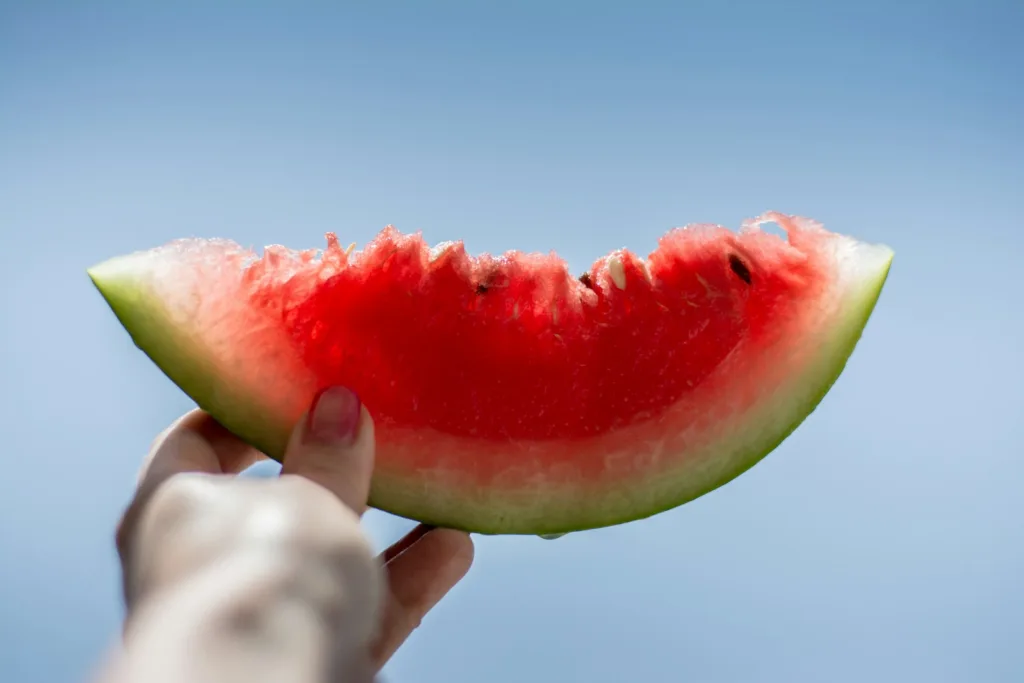
Rinds
When the weather is scorching, there aren’t many things that feel better than consuming a juicy watermelon. Being 91% water, this tasty fruit is ideal for quenching your thirst and maintaining your hydration levels. However, did you know that the rinds of watermelon are also edible? A 2020 study that was published in the journal Molecules found that the rinds are rich in fiber, minerals, amino acids, and antioxidants. These bioactive substances may offer protection against diabetes, cancer, heart disease, and other long-term illnesses.
The way watermelon rinds are served might affect how tasty they are as well. Add them to salads, stir-fry them, or mix them into smoothies. For a crunchy snack, you may even pickle them or roast them in the oven. Consider it an opportunity to sample different flavors, increase the amount of nutrients in your diet, and cut down on food waste. Just be sure to give the rind a good washing to get rid of any pesticide, herbicide, and bacterial residue.
Table of Contents
Watermelon Rinds Can Increase Fullness And Strengthen Your Heart

Less than 1 gram of fiber and over 9 grams of sugar can be found in a cup of watermelon. On the other hand, a 2022 study published in the American-Eurasian Journal of Agricultural and Environmental Sciences states that the rind contains approximately 16% fiber by weight. Furthermore, its sugar content is lower than that of the meat. Dietary fiber lowers blood sugar absorption, promotes fullness, and may even lower cholesterol. It also helps to maintain intestinal health and keeps you regular.
Researchers gave two groups of participants watermelon juice—with or without rind—in a trial conducted in 2021. The study published in Current Developments in Nutrition found that subjects who drank watermelon juice with rinds felt more satisfied after eating and had lower blood sugar levels thereafter. . The rind’s dietary fiber content was probably the cause of these advantageous effects.
High concentrations of citrulline, an amino acid having anti-inflammatory, antioxidant, and cardioprotective properties, are also present in the rind. A 2005 study that was published in the Journal of Chromatography A found that the rind of yellow watermelons contains twice as much citrulline as that of red watermelons and three times as much as that of orange watermelons. According to the journal Molecules, this vitamin may boost protein synthesis, decrease intestinal inflammation, and provide cancer protection. “And for avid athletes who may work out multiple times a day, l-citrulline could increase your performance and help you recover faster,”
The Rind Is Rich in Antioxidants and Vitamins

Rich in coumarin, flavonoids, carotenoids, lignans, and other antioxidants are the rinds of watermelon. According to the journal, these substances scavenge free radicals and combat oxidative stress, which may help prevent cancer, heart disease, and macular degeneration. For instance, beta-carotene may lessen insulin resistance, lower body fat, and improve blood lipids. It might eventually reduce the chance of developing type II diabetes and cardiovascular issues.
Do you still need an excuse to eat the rind? High levels of vitamins B6 and C are present in this section of the fruit. Vitamin B6, or pyridoxine, helps heart health and may alleviate premenstrual syndrome. It’s also necessary for the immune and neurological systems to operate correctly. Likewise, among its many advantages, vitamin C promotes cardiovascular health and immune function.
That’s not all, though. Moderate levels of iron, magnesium, zinc, and other minerals can also be found in watermelon rind. The peel has a potassium content of almost 4% by weight, according to the American-Eurasian Journal of Agricultural and Environmental Sciences. This mineral is necessary for the body to control blood pressure, sodium levels, nerve signals, and muscle contractions. Even while the rind only contains tiny amounts of other minerals, they can still be beneficial to your health.
How to Consume Watermelon Rind Without Losing Taste

Not only is watermelon rind healthy, but it tastes good too. It tastes a little bitter when eaten raw, but it can be enhanced in flavor by cooking or combining it with other things. To begin with, add it to fruit or vegetable salads by grinding it or chopping it into chunks. It can be a great addition to coleslaw or kimchi recipes, as well as Cobb salads. Its delicate taste will allow the other ingredients to shine through.
Do you want a cool summertime smoothie? Combine the rinds of watermelon with the cucumbers, yogurt, lime juice, and dill. Strawberries, raspberries, mangoes, and pineapples also taste great with the rinds; combine them to enhance their flavors. Stir-frying the rind with other vegetables and adding roasted watermelon seeds as a garnish is an additional option. Yes, eating watermelon seeds will provide you with additional iron, zinc, potassium, protein, and B vitamins.
Watermelon rinds are sometimes used in sushi, fritters, chutneys, salsa, and gazpacho. For instance, you can thinly slice the rinds and use them in sushi rolls instead of nori. Blend the rind with tomatoes, cucumbers, garlic, and herbs if you’re in the mood for gazpacho. Accompany it cold with toasted bread, croutons, or crackers. Grated watermelon rinds, flour, eggs, herbs, and spices can also be used to make fritters. Mix all the ingredients together and cook until golden brown. For extra flavor, dip them in mayo, Greek yogurt, or garlic sauce.
you may also like : 8 fruits that promote faster weight loss
Watermelon Rinds: The Secret Superfood We’ve Been Throwing Out (msn.com)

2 thoughts on “Unknown Superfood We’ve Been Disclosing About: Watermelon Rinds 2024”